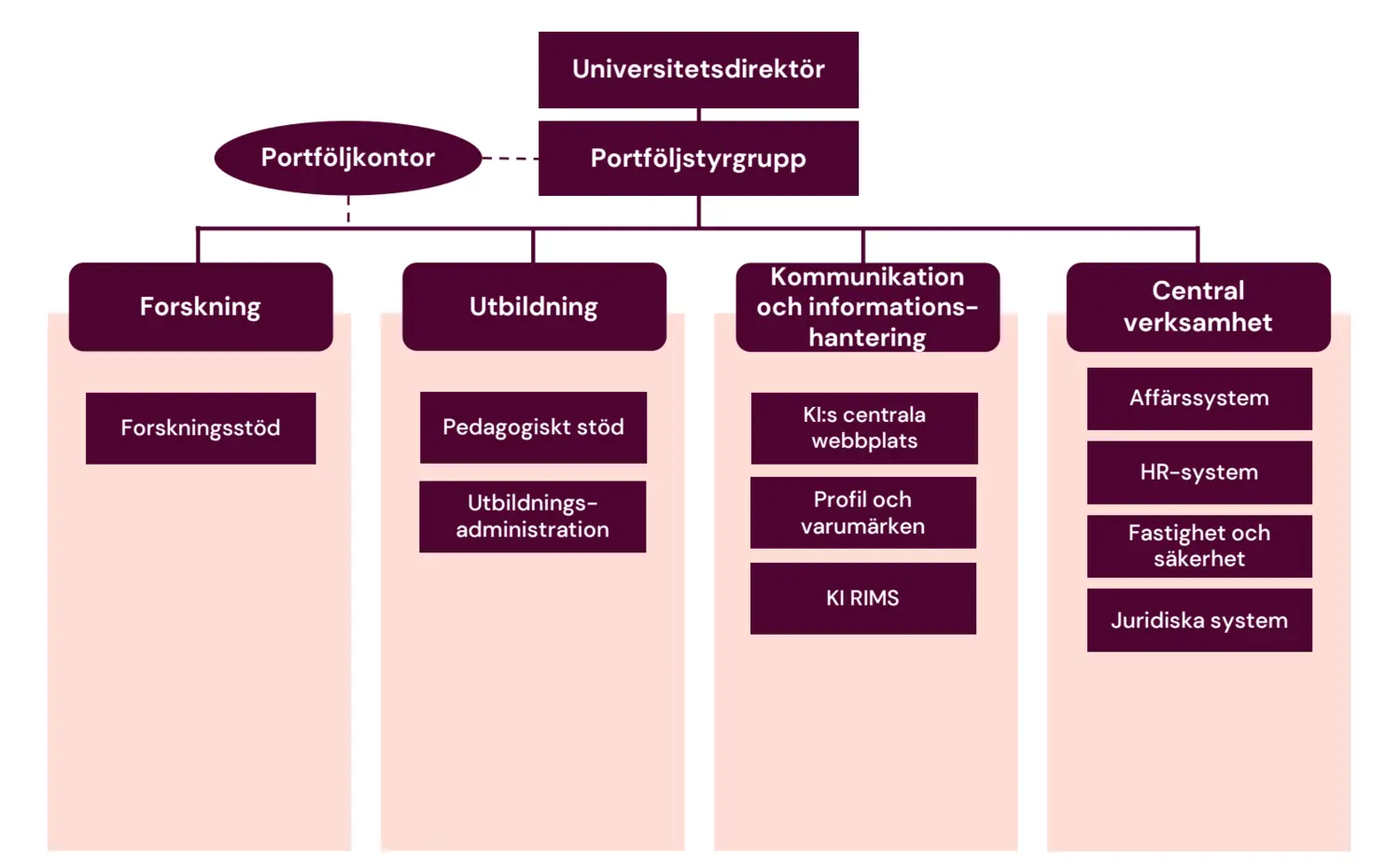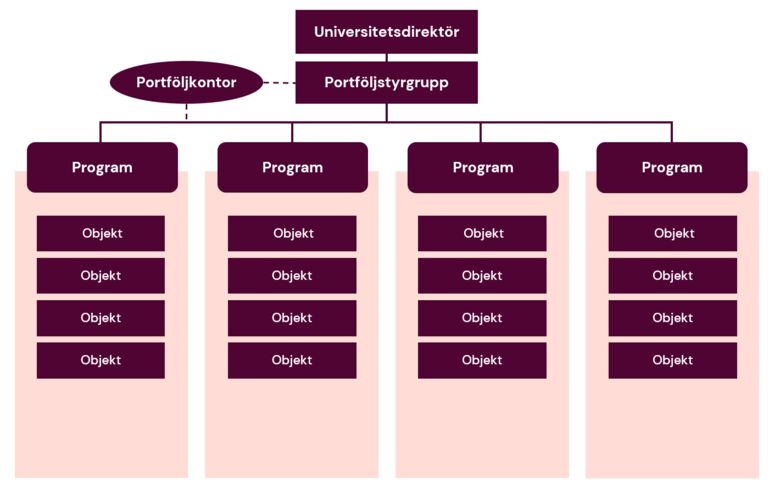The Digitalisation Portfolio
The Digitalisation portfolio brings together KI's IT-related systems in a joint governance and collaboration model. It ensures clear and effective collaboration between core activities, administration and the IT Office.
This page describes the Digitalisation Portfolio in general and the role and work of the Portfolio Office. There is also an overview of the existing programmes, objects and functions included in the portfolio.
The Digitalisation Portfolio in brief
The Digitalisation portfolio is the name of the model at KI, where IT-related systems for operations are managed and coordinated.
It is a multi-level virtual organisation, with representatives from core operations, administrative support offices and the IT Office in different roles. This ensures that all perspectives are included in the management and development work, which leads to clear priorities, cost control and a common approach across KI.
The portfolio currently consists of four programmes:
- Research
- Education and training
- Communication platforms
- Central operations
Under each programme, there are a number of objects, which in turn contain several IT and business components called object products. As a simplified example, we can say that "mirroring your computer on a TV during presentations" is an IT component, while the manual on the table is a supplementary business component.
Each level has different roles with clear responsibilities: Programme Owner, Business Solution Owner, Business Solution Manager and Business Solution Specialist.
Want to understand more about how it works? Read on!

Purpose and mission
Portfolio management was introduced at KI after a completed analysis and subsequent decision by the University Director. Portfolio management was considered to provide better and more precise control of current and future IT systems through clear priorities, well-founded decisions and a joint working method.
In brief, the purpose of the Digitalisation Portfolio at KI is to:
- Ensure that IT support provides the intended benefits at KI.
- Achieve steerability where many organisational parties are involved.
- Clarify roles and responsibilities.
- Coordinate and prioritise management and development efforts.
To achieve this, the Digitalisation Portfolio coordinates and ensures that:
- Development efforts are prioritised based on KI's strategies and agenda.
- There are clear and effective forms of collaboration between core activities, administrative offices, the IT Office and representatives of end users.
- A holistic approach secures shared resources (including budget and expertise).
- Clarity, predictability and a long-term financial perspective are ensured for the administrative support offices.
The portfolio in relation to the linear organisation
The objects in the Digitalisation portfolio are temporary, virtual organisations comparable to project organisations. The work occurs under its form of governance, separate from the line organisation. This means that the objects:
- Contain different roles with clear mandates.
- Facilitates cooperation across organisational boundaries.
- Are responsible for management activities following the object plan.

Governance
The University Director owns the Digitalisation Portfolio and appoints the portfolio steering group.
Each programme has a programme steering group and an object steering group for each object, with respective roles.
You can learn more about the different levels and roles within the portfolio, programme and object below:
Objective
- Ensure that the portfolio effectively supports KI's overall strategy and objectives.
- Creating coherence, synergies and information exchange between the portfolio programmes.
Membership
- Portfolio owner (chair).
- IT Portfolio Owner.
- Programme owner.
- Programme Manager IT.
Support function
Portfolio Office.
Manages and decides on:
- Plans and monitors at a strategic level.
- Establishes the project plans for the coming year.
- Coordinates and decides on issues escalated to the portfolio.
- Changes in the portfolio's object structure.
- AU funding applications.
- Possible conflicts of interest between programmes.
Objective
To create synergies and exchange of information between the programme's objects.
Membership
- Programme Manager (Chair)
- Programme owner IT
- Object owner
- Object owners IT
- Representatives from departments
Support function
Portfolio Office.
Manages and decides on:
- Approves future years' object plans.
- Co-operates on established object plans.
- Monitors the objectives and budget of the objects.
- Coordinates and decides on issues within the programme.
- Overall prioritisation between the objects of the programme.
- Decides on the initiation of projects within the programme area of activity.
- Initiates and prepares proposals for changes in the programme's object structure.
- Develops common strategic objectives within the programme.
- Responsible for outlining the funding needs of the programme.
- Reports to the Portfolio Steering Group.
Purpose
To ensure that the object effectively supports the activities of KI over time.
Membership
- Object owner (chairman)
- Object owner IT
Reporting
- Project manager
- Project manager IT
Manages and decides on:
- Develops, decides on and revises the object plan.
- Ensures that budget and resources are available for planned activities
- Prioritises available resources within the object.
- Monitors costs and objectives of the object.
- Develops strategic objectives.
- Initiates development initiatives for the object.
- Responsible for describing the financing needs of the object.
- Decides on the extension of the members of the object steering group.
- Reports status to Programme Steering Group.
Purpose
Collect requirements and needs for the object to ensure that the object effectively supports KI's activities over time.
Participants
- Object leader (convener)
- Project manager IT
- Business representatives
Manages:
- Needs, requirements and wishes of the organisation.
- Information dissemination and anchoring.
- Testing and evaluating new features.
Roles and responsibilities
Roles with explicit responsibilities, mandates and routes for escalating issues staff each level.
Programme owner
- Represents the programme in the portfolio steering group.
- Reports programme status, outcomes and needs.
- Interacts with Programme owner IT.
- Escalates issues that cannot be handled at programme level.
- Disseminates information to Object owners.
Programme owner IT
- Represents the programme in the portfolio steering group.
- Interacts with Programme owner.
- Escalates issues that cannot be handled at programme level.
- Ensures that decisions made within the portfolio do not go against IT Office recommendations.
- Disseminates information to Object owner IT.
Object owner
- Has the overall responsibility for the operations-related object work.
- Ensures that there are financial means and resources for the object's total management and development.
- Interacts with the Object owner IT.
- Responsible for staffing the roles of Business Solution Manager and Business Solution Specialist.
- Responsible for ensuring that the object complies with applicable laws and internal control documents.
- Responsible for signed agreements within the object.
- Responsible for anchoring and dissemination of information within their own operations.
- Responsible for ensuring that there is an up-to-date object plan.
- Ensures effect collection.
- Represents the object in the programme steering group.
- Reports the object's status, outcomes and needs.
- Escalates issues that cannot be handled at object level.
Object owner IT
- Has the overall responsibility for the IT-related object work.
- Ensures that IT-related costs are compiled for the coming year's object plan and anchored with the Object owner.
- Interacts with the Object owner.
- Responsible for staffing the roles of IT Solution Manager and IT Solution Specialist.
- Responsible for anchoring and information dissemination within its own operations.
- Represents the object in the programme steering group.
- Escalates issues that cannot be handled at object level.
Business Solution Manager
- Draws up the project plan together with the IT Solution Manager.
- Presents reports to the project steering group together with the Project Manager IT.
- Draws up budget documentation, follows up and reports costs within the project.
- Leads project management meetings and anchors and informs within his/her own organisation.
- Leads reference and working groups for capturing requirements and needs.
- Plans, implements and follows up on goals and activities within the framework of the project plan together with the IT Solution Manager.
- Ensures agreements and deliveries from external suppliers.
- Describes and compiles requirements and needs from the project's stakeholders.
- Ensures that acceptance tests are carried out.
- Responsible for information about the project to users/operations.
- Interacts with other projects.
- External monitoring.
IT Solution Manager
- Develops a project plan together with the Business Solution Manager.
- Presents reports in the project steering group together with the Business Solution Manager.
- Prepares budget documentation, monitors and reports IT-related costs within the project.
- Participates in Object management meetings and anchors and informs within his own organisation.
- Participates in reference and working groups for requirements and needs capture.
- Plans, implements and monitors goals and activities within the framework of the project plan together with the Business Solution Manager.
- Is responsible for ensuring that IT support is available to the organisation according to the agreed level.
- Interacts with other projects.
- External monitoring.
Business Solution Specialist
- Contact point and support for users regarding operational issues.
- Participates in Object management meetings.
- Performs management activities on behalf of BSM.
- Supports BSM/IT-SM in preparatory studies, formulation of requirement specifications and definition of impact goals.
- Captures and formulates requirements for IT support from an operational perspective.
- Works with usability from a user perspective.
- Writes and updates user manuals.
- Carries out acceptance tests.
- Trains employees.
IT Solution Specialist
- Contact point and support for users regarding technical issues.
- Participates in Object management meetings.
- Performs management activities on behalf of IT-SM.
- Supports BSM/IT-SM in preparatory studies, preparation of requirement specifications and definition of performance targets.
- Develops and improves systems based on requirements and needs.
- Creates and performs system and integration tests.
- Ensures that current technical information and documentation on the object's IT system is available.
- Performs troubleshooting and error correction.
- Takes part in reference group meetings.
- Collects and communicates needs, requirements and wishes from represented organisation.
- Dissemination of information and support within represented organisation.
- Takes part in task forces if necessary.
Role of the Portfolio Office
The Portfolio Office is the support body for the Digitalisation Portfolio, whose task is to ensure that KI has effective and efficient processes for portfolio management.
The model that KI applies, PM3, clarifies decision-making processes, roles, responsibilities and mandates, which provides a clear link between needs, budget, follow-up and delivery. The digitalisation portfolio and the Portfolio Office work in an operations-oriented manner, which means that support and assistance are based on the needs of the operations.
The portfolio office has an organisational affiliation with the IT Office and the IT Stab unit, and the group's work in brief consists of:
- Ensuring that KI has common processes and working methods for uniform, efficient and effective portfolio management in line with KI's overall strategies.
- Facilitating portfolio and programme steering group meetings.
- Supporting the planning, decision-making and follow-up of the portfolio.
- Supporting the portfolio in coordinating development and project initiatives.
- Coordinating training needs.
- Preparing dossiers.
- Promoting collaboration between the portfolio's stakeholders.
- Running and facilitating collaboration forums and groups.
Contact
Do you have questions about the Digitization Portfolio, programmes or objects? Please contact the Portfolio Office at portfoljkontoret@ki.se
Collaboration workspace for the Digitalisation Portfolio
For those who have an active role in any part of the Digitalisation Portfolio’s programmes and objects, there is a closed site in SharePoint where we share documentation and related news.
